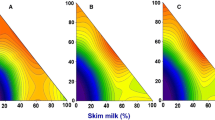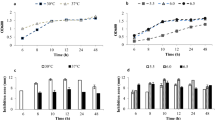Abstract
The effect of nisin regulatory system of the quorum-sensing mechanism and mineral salts on the production of nisin A by the native strain Lactococcus lactis UQ2 growing in skim milk was evaluated using a static culture. A 6 × 3 full factorial design with two replicates was conducted, aiming to study nisin production during growth of L. lactis UQ2 in skim milk as model food. At appropriate time intervals, the produced nisin, microbial population, and medium pH were measured. Sub-inhibitory amounts of commercial nisin (IN; 0, 0.05, 0.65, 1.25, 1.87, and 2.5 μg/L) were added as inducer to skim milk. A mixture of Mg/Mn (MS; 0, 0.5/0.1, and 0.2/0.04 g/L) was also added. These two factors (IN, MS) and their interactions were highly significant for nisin production by L. lactis UQ2. The highest nisin production (75 ± 7 IU/mL) was achieved at 10 h of incubation, for treatment containing 1.87 μg/L of IN and MS 0.5/0.1 g/L, while only 3.5 ± 0.5 IU/mL were produced by control cultures at 6 h. In contrast with other reports, nisin production started at mid-log phase, and the maximum activity was observed well beyond the beginning of the stationary phase (6 h). This was attributed to the effect of IN. Semi-quantification of the structural nisin gene nisA by reverse transcriptase-polymerase chain reaction indicated that it was expressed 2.2 times more than the control treatment. L. lactis UQ2 is different from most strains of this genus, because of its poor lactose consumption and lactic acid production when growing in skim milk. Given the capacity of nisin production and the well-known antimicrobial properties of this bacteriocin, this strain may be useful to enhance the safety of low acidity dairy products such as Mexican-style fresh cheese.




Similar content being viewed by others
References
Axelsson, L. (1998). Lactic acid bacteria: classification and physiology. In S. Salminen & A. von Wright (Eds.), Lactic acid bacteria (pp. 1–72). New York: Marcel Dekker.
Bravo, D., Rodríguez, E., & Medina, M. (2009). Nisin and lacticin 481 coproduction by Lactococcus lactis strains isolated from raw ewes’ milk. Journal of Dairy Science, 92, 4805–4811.
BS 4020. (1974). Methods for the estimation and differentiation of nisin in processed cheese. London: British Standards Institution.
Cárcoba, R., Delgado, T., & Rodríguez, A. (2000). Comparative performance of a mixed strain starter in cow’s milk, ewe’s milk and mixtures of these milks. European Food Research and Technology, 211, 141–146.
Chatterjee, C., Paul, M., Xie, L., & van der Donk, W. A. (2005). Biosynthesis and mode of action of lantibiotics. Chemical Reviews, 105, 633–683.
Cheigh, C. I., Choi, H. J., Park, H., Kim, S. B., Kook, M. C., Kim, T. S., et al. (2002). Influence of growth conditions on the production of a nisin-like bacteriocin by Lactococcus lactis subsp. lactis A-164 isolated from kimchi. Journal of Biotechnology, 95, 225–235.
Cheigh, C. I., Park, H., Choi, H. J., & Pyun, Y. R. (2005). Enhanced nisin production by increasing genes involved in nisin Z biosynthesis in Lactococcus lactis subsp. lactis A164. Biotechnology Letters, 27, 155–160.
Cheigh, C. I., & Pyun, Y. R. (2005). Nisin biosynthesis and its properties. Biotechnology Letters, 27, 1641–1648.
De Vuyst, L., & Vandamme, E. J. (1993). Influence of the phosphorus and nitrogen sources of nisin production in Lactococcus lactis sbsp. lactis batch fermentation using a complex medium. Applied Microbiology and Biotechnology, 40, 17–22.
De Vuyst, L., Callewaert, R., & Crabbé, K. (1996). Primary metabolite kinetics of bacteriocin biosynthesis by Lactococcus amylovorus and evidence for stimulation of bacteriocin production under unfavorable growth conditions. Microbiology, 142, 817–827.
Engelke, G., Gutowsky-Eckel, Z., Kiesau, P., Siegers, M., Hammelmann, M., & Entian, K. D. (1994). Regulation of nisin biosynthesis and immunity in Lacotoccus lactis 6F3. Applied and Environmental Microbiology, 60, 814–825.
FDA (1988) US Food and Drug Administration. Nisin preparation: affirmation of GRAS status as direct human ingredient. 21 Code of Federal Regulations Part 184. Federal Register, 53.
García-Almendárez, B. E., Cann, I. K. O., Martin, S. E., Guerrero-Legarreta, I., & Regalado, C. (2008). Effect of Lactococcus lactis UQ2 and its bacteriocin on Listeria monocytogenes biofilms. Food Control, 19, 670–680.
Harris, I. J., Daeschel, M. A., Stiles, M. E., & Klaenhammer, T. R. (1989). Antimicrobial activity of lactic acid bacteria against Listeria monocytogenes. Journal of Food Protection, 52, 384–387.
Jozala, A. F., Novaes, L. C. L., Cholewa, O., Moraes, D., & Penna, T. C. V. (2005). Increase of nisin production by Lactococcus lactis in different media. African Journal of Biotechnology, 4, 262–265.
Jozala, A. F., Sayuri de Andrade, M., Juncioni de Araiz, L., Pessoa, A., & Penna, T. C. V. (2007). Nisin production utilizing skimmed milk aiming to reduce process cost. Applied Biochemistry and Biotechnology, 136–140, 515–528.
Kim, W. S. (1997). Nisin production by Lactococcus lactis using two-phase batch culture. Letters in Applied Microbiology, 25, 169–171.
Kim, W. S., Hall, R. J., & Dunn, N. W. (1998). Improving nisin production by increasing nisin immunity/resistance genes in the producer organism Lactococcus lactis. Applied Microbiology and Biotechnology, 50, 429–433.
Kleerebezem, M. (2004). Quorum sensing control of lantibiotic production; nisin and subtilin autoregulate their own biosynthesis. Peptides, 25, 1405–1414.
Kleerebezem, M., & Quadri, L. E. (2001). Peptide pheromone-dependent regulation of antimicrobial peptide production in Gram-positive bacteria: a class of multicellular behavior. Peptides, 22, 1579–1596.
Kleerebezem, M., Kuipers, O. P., & de Vos, W. M. (1997). Quorum sensing by peptide pheromones and two-components signal transduction system in Gram-positive bacteria. Molecular Microbiology, 24, 895–904.
Kuipers, O. P., Beerthuyzen, M. M., de Ruyter, P. G. A., Luesink, E. J., & de Vos, W. M. (1995). Autoregulation of nisin biosynthesis in Lactococcus lactis by signal transduction. Journal of Biological Chemistry, 270, 27299–27304.
Kwaadsteniet, M., Doeschate, K., & Dicks, L. M. T. (2008). Characterization of the structural gene encoding nisin F, a new lantibiotic producer by a Lactococcus lactis subsp. lactis isolated from freshwater catfish (Clarias gariepinus). Applied and Environmental Microbiology, 74, 547–549.
Li, C., Bai, J., Cai, Z., & Ouyang, F. (2002). Optimization of a culture medium for bacteriocin production by Lactococcus lactis using response surface methodology. Journal of Biotechnology, 93, 27–34.
Linnan, M. J., Mascola, J., Lou, X. D., Goulet, V., May, S., Salminen, C., et al. (1988). Epìdemic listeriosis associated with Mexican-style cheese. New England Journal of Medicine, 319, 823–828.
Liu, C., Liu, Y., Liao, W., Wen, Z., & Chen, S. (2003). Application of statistically-based experimental designs for the optimization of nisin production from whey. Biotechnology Letters, 25, 877–882.
MacDonald, P. D. M., Whitwam, R. E., Boggs, J. D., MacCormack, J. N., Anderson, K. L., & Reardon, J. W. (2005). Outbreak of listeriosis among Mexican immigrants as a result of consumption of illicitly produced Mexican-style cheese. Clinical Infectious Diseases, 40, 677–682.
Penna, T. C. V., & Moraes, D. A. (2002). Optimization of nisin production by Lactococcus lactis. Applied Biochemistry and Biotechnology, 98–100, 775–789.
Peña, G. G. (2005). Use of whey for production of bacteriocins by Lactococcus lactis UQ2 in a bioreactor. MS Thesis. Facultad de Química, Universidad Autónoma de Querétaro, México.
Pongtharangkul, T., & Demirci, A. (2004). Evaluation of agar diffusion bioassay for nisin quantification. Applied Microbiology and Biotechnology, 65, 268–272.
Pongtharangkul, T., & Demirci, A. (2006). Evaluation of culture medium for nisin production in a repeated-batch biofilm reactor. Biotechnology Progress, 22, 217–224.
Raccach, M. (1985). Manganese and lactic acid bacteria. Journal of Food Protection, 48, 895–898.
Sambrook, J., & Russell, D. W. (2001). Molecular cloning. A laboratory manual, Vol 1, 3rd ed (pp. 5.55–5.60, 7.9–7.12, 8.46–8.53). Cold Spring Harbor: Cold Spring Harbor Laboratory Press.
Scannell, A. G. M., Schwarz, G., Hill, C., Ross, R. P., & Arendt, E. K. (2001). Pre-inoculation enrichment procedure enhances the performance of bacteriocinogenic Lactococcus lactis meat starter culture. International Journal of Food Microbiology, 64, 151–159.
Statpoint Technologies (2006). Statgraphics plus version 4.0.Warrenton, VA, USA.
Stein, T., Heinzmann, S., Solovieva, I., & Entian, K. D. (2003). Function of Lactococcus lactis nisin immunity genes nisI and nisFEG after coordinated expression in the surrogate host Bacillus subtilis. Journal of Biological Chemistry, 278, 89–94.
Thomas, L. V., & Delves-Broughton, J. (2005). Nisin. In P. M. Davidson, J. N. Sofos & A. L. Branen (Eds.), Antimicrobials in food (3rd ed., pp. 237–274). Boca Raton: Taylor & Francis.
USDA-NASS (2007) United States Department of Agriculture National Agricultural Statistics Service. Dairy Products 2006 Summary. Available at: (http://www.nass.usda.gov./Publications/Today_Reports/reports/daryan07.txt).
Valbuena, E., Barreiro, J., Sánchez, E., Castro, G., Bríñez, W., & Tovar, A. (2005). Growth kinetics models applied to Lactococcus lactis sbsp. lactis in milk. Revista Científica FCV-LUZ, 5, 464–475.
Willey, J. M., & van der Donk, W. A. (2007). Lantibiotics: peptides of diverse structure and function. Annual Review of Microbiology, 61, 477–501.
Yang, R., Johnson, M. C., & Ray, B. (1992). Novel methods to extract large amounts of bacteriocins from lactic acid bacteria. Applied and Environmental Microbiology, 58, 3355–3359.
Zwietering, N. H., Jongenburger, I., Rombouts, F. M., & van’t Riet, K. (1990). Modelling of the bacterial growth curve. Applied and Environmental Microbiology, 56, 1875–1881.
Acknowledgments
Thanks are given to CONACYT for PhD scholarship to MDGP and FOMIX CONACYT-QRO for grant No. QRO-2008-CO2-101687 (Mexico).
Author information
Authors and Affiliations
Corresponding author
Rights and permissions
About this article
Cite this article
García-Parra, M.D., García-Almendárez, B.E., Guevara-Olvera, L. et al. Effect of Sub-inhibitory Amounts of Nisin and Mineral Salts on Nisin Production by Lactococcus lactis UQ2 in Skim Milk. Food Bioprocess Technol 4, 646–654 (2011). https://doi.org/10.1007/s11947-009-0287-7
Received:
Accepted:
Published:
Issue Date:
DOI: https://doi.org/10.1007/s11947-009-0287-7




